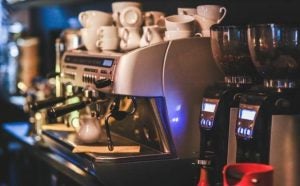Many people may not be aware that lead is still added to brass and bronze used to make drinking water faucets and food equipment like coffee brewers and more. This is problematic because lead can leach into the water and beverages from the equipment – putting consumers at risk. As part of EDF’s efforts to reduce exposure to lead from all sources, we have advocated to stop this use of the heavy metal.
Last June, our three-year effort yielded results when the committee responsible for the national consensus standard for plumbing devices, known as NSF/ANSI/CAN 61, made its lead leaching standard five times more protective for endpoint devices – from 5 to 1 parts per billion. Endpoint devices are faucets, drinking water fountains and other devices installed within the last one liter of water distribution systems in a building. For all other plumbing devices, lead is limited to the amount added to the device’s material, 2500 parts per million (ppm) [1], and leaching limit does not apply.
This fall, we turned our attention to lead leaching into drinking water from food equipment such as ice machines, coffee brewers, teapots, and water heaters. We have submitted petitions to NSF International and to the Food and Drug Administration (FDA) asking them to prohibit use of lead in brass and bronze commonly used in these devices.
For food equipment, we leveraged the more protective safety standards for food contact substances in the Food Additives Amendment of 1958. These standards require that additives not be used unless there is a reasonable certainty of no harm from their intended use after taking into account related substances in the diet. It also prohibits use of carcinogens. Lead is unsafe under both these restrictions because it is a carcinogen and no safe threshold has been found for lead in the blood to prevent neurologic development harm in children and heart disease in adults.
Petition to tighten national consensus standard for food equipment materials: NSF/ANSI 51
NSF/ANSI 51 bans lead broadly but explicitly allows its use in brass and bronze up to 2,500 ppm for tea, coffee, and water equipment. And, unlike NSF/ANSI/CAN 61, which also addresses lead from brass and bronze into water, the equipment is not tested for leaching.
In November, EDF, Healthy Babies Bright Future, A Community Voice, Lead and Environmental Hazards Association, and Center for Environmental Health submitted a formal request to the committee responsible for NSF/ANSI 51 asking that it revise the standard by:
- Removing the exemption that allows lead’s use in brass and bronze up to 2,500 ppm; and
- Presuming that lead levels over 100 ppm in the material are evidence of intentional use unless the Food and Drug Administration (FDA) has formally authorized the use.
We expect the committee to ask a task group to take up the petition in a January meeting.[2] I sit on the task group.
Petition to FDA to ban lead as an additive for food contact substances
In December, EDF and ten health, consumer and environmental groups[3] submitted a citizens petition to FDA asking it to adopt rules explicitly banning the use of lead as an additive in food contact articles. This ban would apply to lead in brass, bronze, and tin used to coat metal cans and plastics, inks, and other coatings for food contact materials.
As in our request to change NSF/ANSI 51, we ask the agency for a ban on use of lead in these materials coupled with a presumption that levels over 100 ppm represent an intentional use. FDA can still specifically authorize the use but only if:
- The part of the food contact article that contains added lead does not contact food under intended conditions of use; or
- No lead migrates into food from the food contact article under intended conditions of use.
The agency posted the petition for public comment and must make a decision how to proceed by June 2021. There is no deadline for comments but it is best to submit them by April 1 so they can influence the agency’s determination.
Why it’s important to get the lead out of brass and bronze
Progress on protecting children and adults from the risks posed by lead takes a concerted effort to drive down all sources of exposures. The use of lead in brass and bronze is unnecessary; safer alternatives are available. We anticipate that FDA and the committee responsible for NSF/ANSI 51 will take prompt action to adopt our recommendations.
By Tom Neltner
Tom Neltner, J.D. is the Chemicals Policy Director.
[1] The limit is based on a weighted average of total lead in the wetted parts of the device. This approach allows small parts in contact with the water to have much higher levels of lead as long as average weight is less than 2500 ppm. Note that the limit is 2000 ppm for solder and fluxes.
[2] I sit on the task group.
[3] Breast Cancer Prevention Partners, Center for Food Safety, Clean Label Project, Consumer Reports, Defend Our Health, Environmental Working Group, Healthy Babies Bright Futures, and Utah Physicians for a Healthy Environmental.
Enviroshop is maintained by dedicated NetSys Interactive Inc. owners & employees who generously contribute their time to maintenance & editing, web design, custom programming, & website hosting for Enviroshop.

